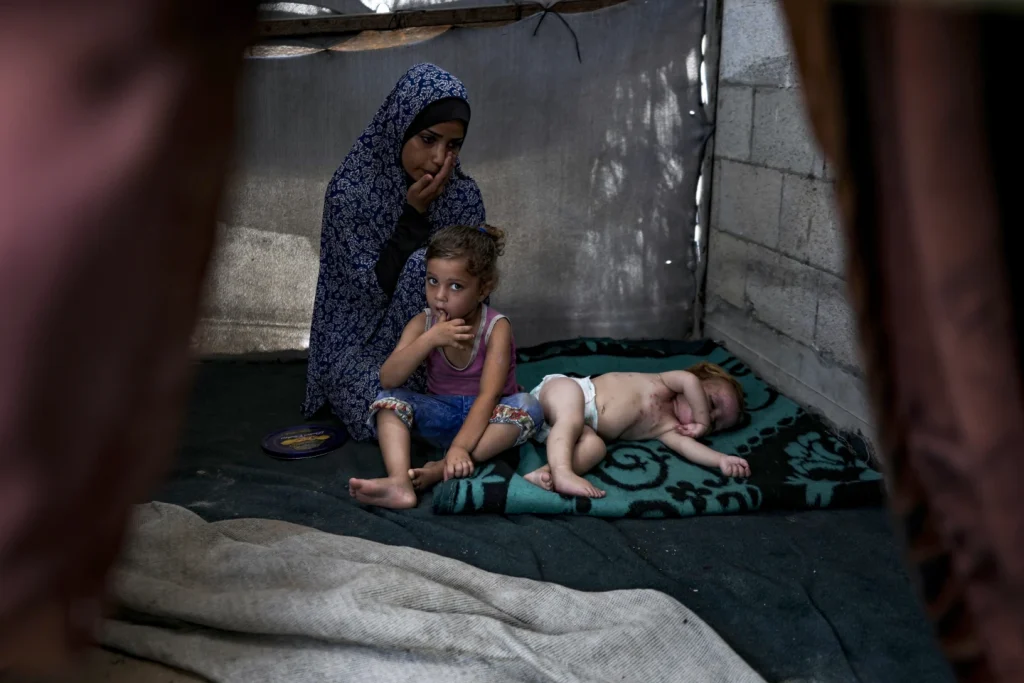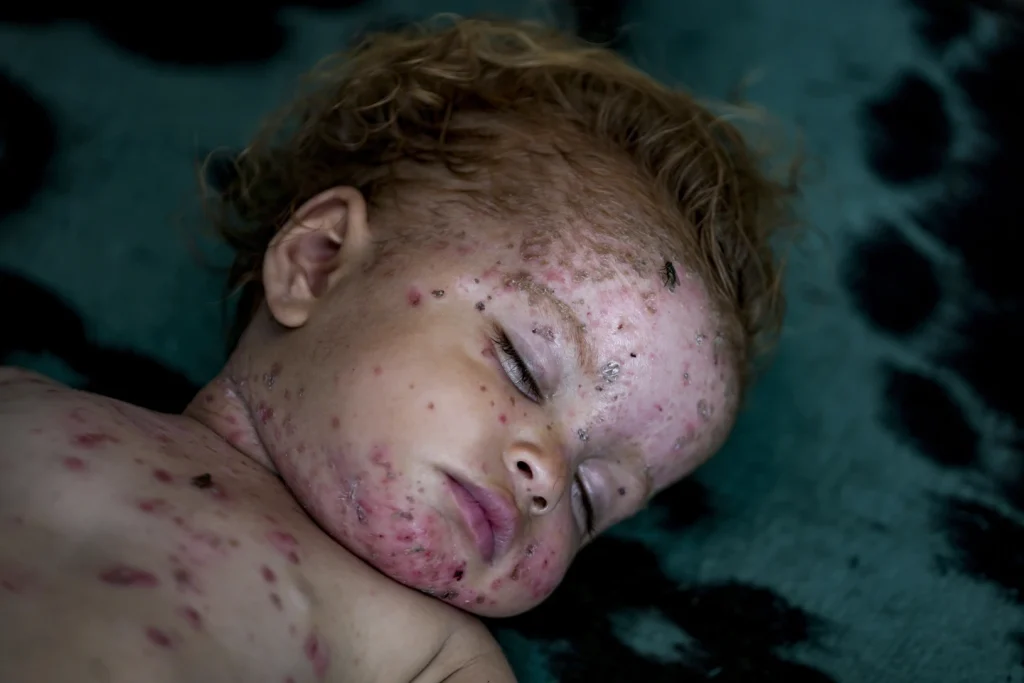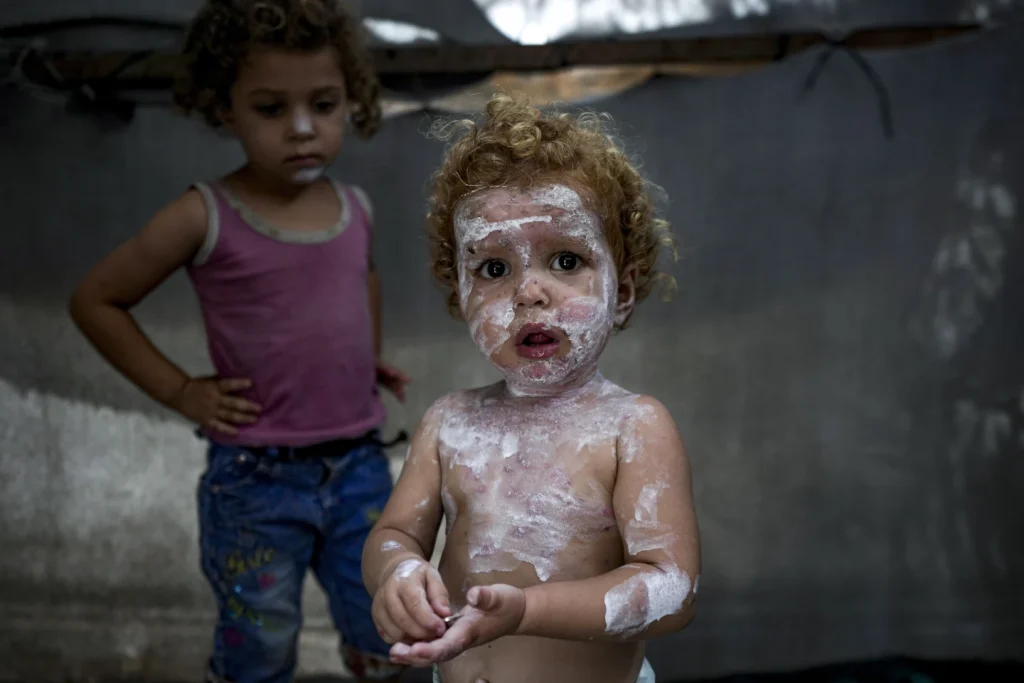Amidst the chaos and suffering in the Gaza Strip, the plight of children afflicted with a myriad of skin diseases paints a heartbreaking picture of the harsh reality faced by residents in overcrowded tent camps.
The scene at the dermatology office in Nasser Hospital in central Gaza is a poignant reflection of the health crisis unfolding in the region, where parents bear the weight of witnessing their children endure pain and discomfort.
The harrowing accounts of mothers presenting their distressed children to doctors, showcasing the distressing symptoms ranging from red and white spots to open sores, highlight the dire situation faced by families trapped in deplorable conditions.
The combination of overcrowded living spaces, scorching summer temperatures, and the breakdown of sanitation infrastructure due to ongoing conflicts has created a breeding ground for infectious skin conditions to proliferate.
Health officials in Gaza echo alarming reports of a sharp rise in skin diseases, with staggering numbers of cases including lice, scabies, skin rashes, acute respiratory infections, diarrhea, and jaundice.
The statistics provided by international organizations paint a grim picture of the health crisis unfolding in the densely populated territory, where basic hygiene practices become a luxury in the face of squalid living conditions.
The lack of access to essential hygiene products such as soap and shampoo, coupled with contaminated water sources and inadequate sanitation facilities, exacerbates the already dire situation faced by displaced families living in makeshift tent camps.
The desperation expressed by residents like Munira al-Nahhal, residing in a tent amidst sand dunes outside Khan Younis, underscores the daily struggles endured by families grappling with pervasive skin diseases that afflict their children.
As one child after another succumbs to skin ailments, spreading among siblings and relatives within the cramped confines of makeshift shelters, the cycle of suffering perpetuates, underscoring the urgent need for intervention and support.

The inability to maintain basic cleanliness standards, amidst a backdrop of sand, insects, and filth, symbolizes the systemic failure to protect the most vulnerable members of society from preventable health hazards.
In light of the unfolding health crisis in Gaza, addressing the root causes of the epidemic goes beyond mere medical treatment; it necessitates a comprehensive approach encompassing humanitarian aid, infrastructure development, and long-term solutions to alleviate the suffering of displaced populations.
The voices of those like Munira al-Nahhal, speaking out about the insurmountable challenges faced by families in tent camps, serve as a poignant reminder of the urgent need for collective action to mitigate the impact of rampant skin diseases and safeguard the well-being of innocent children caught in the crossfire of conflict.
In conclusion, the narrative of suffering and resilience exemplified by the children and families grappling with skin diseases in Gaza’s tent camps underscores the urgent call for compassionate intervention and sustainable solutions to alleviate their plight.
The onus lies on the global community to heed their cries for help and work towards creating a more humane and dignified existence for those who have known nothing but hardship and adversity.
The dire living conditions faced by Palestinians in the camp highlight a humanitarian crisis of immense proportions. Clean water, a basic necessity for life, is a luxury that many in the camp cannot afford or access easily.
The struggle for clean water forces families to resort to using salt water from the nearby Mediterranean for essential tasks, such as bathing their children.
The lack of clean water extends to the point where individuals are compelled to wear the same clothes repeatedly, enduring unhygienic conditions until they can finally wash their garments.
Furthermore, the omnipresence of flies and children playing amidst garbage-strewn sand further exacerbates the unsanitary environment in which these individuals reside.
The poignant account of Shaima Marshoud, alongside her ailing daughter, sheds light on the harsh reality faced by families in the camp.
The anguish and helplessness in Shaima’s voice as she describes her daughter’s skin condition, worsened by the lack of access to medical treatment due to financial constraints, underscores the profound suffering experienced by many in the community.
The overcrowding resulting from the displacement of a significant portion of Gaza’s population, paired with the absence of proper sewage systems and limited water resources, compounds the challenges faced by these vulnerable individuals.
The disruption in the distribution of humanitarian aid, including essential items such as soap, shampoo, and medicines, further deepens the crisis within the camp.
The precarious security situation, characterized by Israeli military operations and general lawlessness, impedes the timely and efficient delivery of much-needed relief supplies to those in need.
This grim reality underscores the urgency of addressing not only the immediate health concerns but also the broader systemic issues contributing to the ongoing humanitarian catastrophe in Gaza.
The collapse of the solid waste management system, as highlighted by Chitose Noguchi of the UNDP, poses a severe threat to public health within the camp. The proliferation of informal dumping sites, some containing hazardous pools of human waste and garbage, creates a breeding ground for infectious diseases and environmental degradation.
The precarious living conditions, characterized by inadequate shelter and proximity to these hazardous sites, further jeopardize the well-being of the inhabitants, particularly in terms of the escalating health crisis.
The harrowing accounts provided by Nassim Basala, a dermatologist at Nasser Hospital, paint a grim picture of the overwhelming burden faced by healthcare professionals in treating the surge of patients afflicted with skin diseases.
The prevalence of skin infections, exacerbated by unsanitary living conditions and lack of access to adequate medical care, underscores the urgent need for resources and support to mitigate the escalating health crisis.
The detrimental impact of untreated skin conditions, leading to severe complications such as kidney failure, serves as a stark reminder of the life-threatening consequences of neglecting basic healthcare needs.

The profound suffering experienced by children and adults alike, as illustrated by the distressing accounts of individuals seeking medical care for persistent skin ailments, underscores the urgency of addressing the multifaceted challenges confronting the community in the camp.
The lack of basic hygiene products, coupled with inadequate medical supplies, exacerbates the suffering of individuals grappling with painful and debilitating conditions.
The struggles faced by parents in comforting their children amidst the pervasive filth and unsanitary conditions epitomize the profound human cost of the ongoing humanitarian crisis in Gaza.
In conclusion, the plight of Palestinians in the camp serves as a poignant reminder of the urgent need for concerted international efforts to address the intersecting crises of inadequate access to clean water, deteriorating health conditions, and environmental degradation.
The dire circumstances facing these vulnerable individuals demand not only immediate humanitarian assistance but also sustained long-term solutions to alleviate their suffering and restore dignity to their lives.
Only through coordinated action and a commitment to upholding the fundamental rights and dignity of all individuals can we hope to bring about meaningful change and alleviate the profound human suffering endured by those in Gaza.
